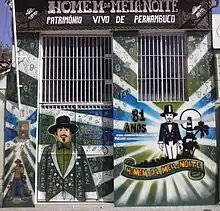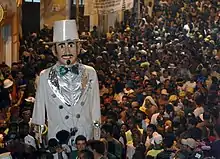 Headquarter at Olinda's historical center | |
 Midnight Man's doll at 2008 parade | |
| Full name | Clube Carnavalesco de Alegoria e Crítica O Homem da Meia-Noite |
|---|---|
| Foundation | February 2, 1931 |
| Symbol | man with a Van Dyke beard and gold tooth dressed in a suit with a Bow tie and top hat |
| Location | Olinda |
O Homem da Meia-Noite (Portuguese for 'The Midnight Man') is a carnival block in Olinda, Brazil. The block was created in 1931 by Luciano Anacleto de Queiroz, Sebastião da Silva, Cosme José dos Santos, Heliodoro Pereira da Silva, and shoemaker Manoel Joaquim dos Santos. It parades on carnival Saturday midnight at Olinda's historical center, being the first block to perform.[1] frevo is the main played rhythm, but others are also played, such as samba and marchinhas.
O Homem da Meia Noite is an intangible cultural heritage of Pernambuco since 2006.[2]
History
Homem da Meia-Noite was founded on February 2, 1931, following an internal dispute at Cariri Olindense. Luciano Anacleto de Queiroz, Sebastião da Silva, Cosme José dos Santos, Heliodoro Pereira da Silva, and shoemaker Manoel Joaquim dos Santos (Neco Monstro) were not accepted at the block's board, and decided to create the new block. Back then, Cariri Olindense was the first block to parade at Olinda's carnival. Thus, to rival with them, the founders decided to parade at the midnight hour between carnival's Saturday and Sunday, becoming the opening act since then. Later, both blocks have reconciled. Now it is a tradition that Homem da Meia-Noite hands in the city key to Cariri right after its parade. [3]
Between 1931 and 1932, Homem da Meia-Noite had only a standard (with a clock showing midnight hour) and the doll. After, it has incorporated other carnival elements. The block did not parade between 1950 and 1953 due to financial issues.
Family

Other characters have been created in association to Homem da Meia-Noite. A Mulher do Dia (Portuguese for 'The Day Woman') was created in 1967.[4] The doll only parades on Sunday, thus only meets Homem da Meia Noite when all giant dolls parade together. The figure was created by the craftsman Julião das Máscaras, whom inspired at Monalisa. It has long dark hair, a gold tooth smile, and wears yellow and blue in a reference to Yemọja e Oshun. Homem and Mulher were "officially" married in a ceremony in February 1990.[5]
O Menino da Tarde (Portuguese for 'The Afternoon Boy') is the first offspring of the marriage between Homem da Meia-Noite and Mulher do Dia. The figure was create in 1974 also by Julião das Máscaras. He is dressed as an adult. In 1977 A Menina da Tarde (Portuguese for 'The Afternoon Girl') was created by Sílvio Botelho. The character is vain girl which has news clothes every carnival.
References
- ↑ NE10. "História misteriosa do Homem da Meia-Noite comemora 80 anos nesta quinta" [The mysterious story of the Midnight Man turns 80 this Thursday]. Archived from the original on 2012-02-06. Retrieved 2012-10-29.
{{cite web}}: CS1 maint: numeric names: authors list (link) - ↑ Amorim, Maria Alice (2010). Patrimônios Vivos de Pernambuco [Live Heritage of Pernambuco]. Recife: FUNDARPE. Retrieved 2013-03-25.
- ↑ Roberto Saraiva (2013-02-10). "Homem da Meia-Noite emociona Olinda" [Homem da Meia-Noite cheers Olinda] (in Portuguese). UOL. Retrieved 2013-02-23.
- ↑ Caio Rodrigues (2010-02-09). "Com um metro e 40 cm e 40 kg, boneco gigante Mulher do Dia é ícone do Carnaval olindense" [With 1.40m and 40kg, the giant doll of Mulher do Dia is an icon of the carnival in Olinda] (in Portuguese). Olinda Carnaval. Retrieved 2013-02-25.
- ↑ Tatiana Notaro (2020-02-15). "Homem da Meia Noite e Mulher do Dia completam Bodas de Pérolas" [Homem da Meia Noite and Mulher do Dia complete Perl wedding anniversary] (in Portuguese). G1. Retrieved 2020-02-15.